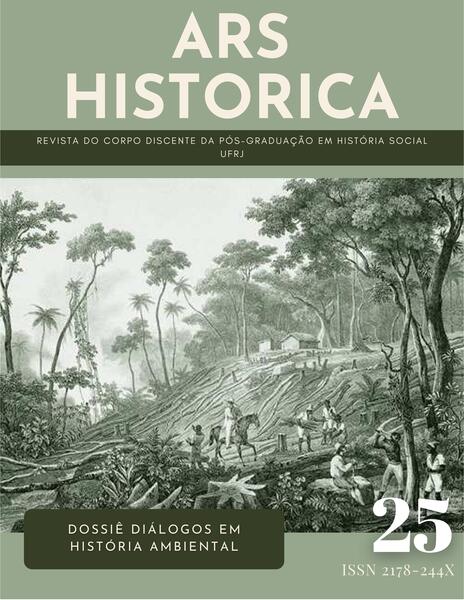NOTAS PARA UMA ETNOGRAFIA MULTIESPÉCIE COM COIOTES NA PROVÍNCIA DE CARTAGO, COSTA RICA
Palavras-chave:
Agenciamento, Mais-do-que-humano, Relações humanos-animais.Resumo
Neste artigo se apresentam alguns elementos para entender os relacionamentos entre humanos e coiotes (Canis Latrans) na província de Cartago, na Costa Rica. Exploram-se os potenciais metodológicos da etnografia multiespécie, enquanto ferramenta que favorece o estudo de dinâmicas de coexistência entre humanos e não humanos. Incorpora-se o conceito de “mobilidades dos animais” (animal’s mobilities) para refletir sobre a biopolítica da conservação aplicada aos coiotes e questionar as práticas acionadas na pesquisa atual sobre os deslocamentos da espécie em áreas vizinhas do Parque Nacional Vulcão Irazú – Setor Prusia, um dos principais habitats dos coiotes. Conclui-se que as diferentes intensidades afetivas e emocionais envolvidas nos encontros humanos-coiotes em espaços rurais, urbanos e periurbanos são um fenômeno que precisa ser estudado de maneira mais detalhada.Downloads
Referências
BARUA, Maan. Affective economies, pandas, and the atmospheric politics of lively capital. Transactions of the Institute of British Geographers, v. 45, n. 3, p. 678-692, 2020.
BARUA, Maan; SINHA, Anindya. Animating the urban: An ethological and geographical conversation. Social & Cultural Geography, v. 20, n. 8, p. 1160-1180, 2019.
BENNETT, Jane. Vibrant Matter: A Political Ecology of Things. Durham, N.C.: Duke University Press, 2010.
BOONMAN‐BERSON, Susan; et al. Managing wild minds: From control by numbers to a multinatural approach in wild boar management in the Veluwe, the Netherlands. Transactions of the Institute of British Geographers, v. 44, n. 1, p. 2-15, 2019.
HINCHLIFFE, Steve, et al. Urban wild things: a cosmopolitical experiment. Environment and planning D: Society and Space, v. 23, n. 5, p. 643-658, 2005.
HODGETTS, Timothy. Connectivity as a multiple: In, with and as “nature”. Area, v. 50, n. 1, p. 83-90, 2018.
HODGETTS, Timothy; LORIMER, Jamie. Animals’ mobilities. Progress in Human Geography, v. 44, n. 1, p. 4-26, 2020.
HODY, James W.; KAYS, Roland. Mapping the expansion of coyotes (Canis latrans) across North and Central America. ZooKeys, n. 759, p. 81-97, 2018.
INEC (Instituto Nacional de Estadística y Censo de Costa Rica), XI Censo Nacional de Población y VII de Vivienda, Resultados Generales. Imprenta INEC, San José, Costa Rica, 2022.
KIRKSEY, S. Eben; HELMREICH, Stefan. The emergence of multispecies ethnography. Cultural anthropology, v. 25, n. 4, p. 545-576, 2010.
KIRKSEY, Eben, et al. The Xenopus pregnancy test: A performative experiment. In: ROGERS, Hannah Star, et al. (Eds). Routledge Handbook of Art, Science, and Technology Studies. Routledge, 2021. p. 163-178.
LA GACETA. Reglamento a la Ley de Biodiversidad. Decreto Ejecutivo Nº 34433. Costa Rica, 2008. Disponível em: .
LESTEL, Dominique, et al. Etho-Ethnology and Ethno-Ethology. Social Science Information, v. 45, n. 2, p. 155–177, 2006.
LORIMER, Jamie. Wildlife in the Anthropocene: conservation after nature. USA: U of Minnesota Press, 2015.
LORIMER, Jamie; et al. Animals’ atmospheres. Progress in Human Geography, v. 43, p. 26-45, 2017.
MASON, Victoria; HOPE, Paul R. Echoes in the dark: Technological encounters with bats. Journal of Rural Studies, v. 33, p. 107-118, 2014.
MONROY‐VILCHIS, Octavio, et al. Coyote (Canis latrans) in South America: potential routes of colonization. Integrative Zoology, v. 15, n. 6, p. 471-481, 2020.
PARKS, Lisa. Mediating animal-infrastructure relations. In: Boucher, Marie-Pier; et al. (Eds). Being Material. Cambridge, MA: MIT Press, 2017, p.144–153.
SHAPIRO, Nicholas; KIRKSEY, Eben. Chemo-ethnography: An introduction. Cultural Anthropology, v. 32, n. 4, p. 481-493, 2017.
SINAC (Sistema Nacional de Áreas de Conservación. Definición de los componentes estructurales del SINAC. Costa Rica: SINAC, 2013. Disponível em .
TSING, Anna. More-than-human sociality: a call for critical description. In: HASTRUP, Kirsten (Ed.). Anthropology and nature. New York: Routledge Press, 2014, p. 27–42.
UMAÑA, Wilson Picado; DÍAZ, Rafael Ledezma; PORRAS, Roberto Granados. Territorio de coyotes, agroecosistemas y cambio tecnológico en una región cafetalera de Costa Rica. Revista de Historia, n. 59-60, p. 119-165, 2009.
VAN DOOREN, Thom; KIRKSEY, Eben; MÜNSTER, Ursula. Multispecies StudiesCultivating Arts of Attentiveness. Environmental Humanities, v. 8, n. 1, p. 1-23, 2016.
VON UEXKÜLL, Jakob. A stroll through the worlds of animals and men: A picture book of invisible worlds. Semiotica, v. 89, n. 4, p. 319-391, 1992.
WHATMORE, Sarah. Materialist returns: Practising cultural geography in and for a more‐than‐human world. Cultural Geographies, v. 13, p. 600-609, 2006.
__. Mapping knowledge controversies: science, democracy and the redistribution of expertise. Progress in Human Geography, v. 33, n. 5, p. 587-598, 2009.
Downloads
Publicado
Edição
Seção
Licença
Autores que publicam nesta revista concordam com os seguintes termos:
Autores mantém os direitos autorais e concedem à revista o direito de primeira publicação;
As opiniões emitidas pelos autores são de sua exclusiva responsabilidade e não refletem a opinião da Ars Historica.

